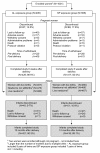Safety of artemether-lumefantrine in pregnant women with malaria: results of a prospective cohort study in Zambia
- PMID: 20809964
- PMCID: PMC2944339
- DOI: 10.1186/1475-2875-9-249
Safety of artemether-lumefantrine in pregnant women with malaria: results of a prospective cohort study in Zambia
Abstract
Background: Safety data regarding exposure to artemisinin-based combination therapy in pregnancy are limited. This prospective cohort study conducted in Zambia evaluated the safety of artemether-lumefantrine (AL) in pregnant women with malaria.
Methods: Pregnant women attending antenatal clinics were assigned to groups based on the drug used to treat their most recent malaria episode (AL vs. sulphadoxine-pyrimethamine, SP). Safety was assessed using standard and pregnancy-specific parameters. Post-delivery follow-up was six weeks for mothers and 12 months for live births. Primary outcome was perinatal mortality (stillbirth or neonatal death within seven days after birth).
Results: Data from 1,001 pregnant women (AL n = 495; SP n = 506) and 933 newborns (AL n = 466; SP n = 467) showed: perinatal mortality (AL 4.2%; SP 5.0%), comprised of early neonatal mortality (each group 2.3%), stillbirths (AL 1.9%; SP 2.7%); preterm deliveries (AL 14.1%; SP 17.4% of foetuses); and gestational age-adjusted low birth weight (AL 9.0%; SP 7.7%). Infant birth defect incidence was 1.8% AL and 1.6% SP, excluding umbilical hernia. Abortions prior to antenatal care could not be determined: abortion occurred in 4.5% of women treated with AL during their first trimester; none were reported in the 133 women exposed to SP and/or quinine during their first trimester. Overall development (including neurological assessment) was similar in both groups.
Conclusions: These data suggest that exposure to AL in pregnancy, including first trimester, is not associated with particular safety risks in terms of perinatal mortality, malformations, or developmental impairment. However, more data are required on AL use during the first trimester.
Figures
Similar articles
-
Safety of artemether-lumefantrine exposure in first trimester of pregnancy: an observational cohort.Malar J. 2014 May 27;13:197. doi: 10.1186/1475-2875-13-197. Malar J. 2014. PMID: 24884890 Free PMC article.
-
Exposure to artemether-lumefantrine (Coartem) in first trimester pregnancy in an observational study in Zambia.Malar J. 2015 Feb 14;14:77. doi: 10.1186/s12936-015-0578-6. Malar J. 2015. PMID: 25877884 Free PMC article.
-
Pharmacovigilance of artemether-lumefantrine in pregnant women followed until delivery in Rwanda.Malar J. 2012 Jul 6;11:225. doi: 10.1186/1475-2875-11-225. Malar J. 2012. PMID: 22770264 Free PMC article.
-
A systematic review of the safety and efficacy of artemether-lumefantrine against uncomplicated Plasmodium falciparum malaria during pregnancy.Malar J. 2012 May 1;11:141. doi: 10.1186/1475-2875-11-141. Malar J. 2012. PMID: 22548983 Free PMC article.
-
Pregnancy outcomes after first-trimester treatment with artemisinin derivatives versus non-artemisinin antimalarials: a systematic review and individual patient data meta-analysis.Lancet. 2023 Jan 14;401(10371):118-130. doi: 10.1016/S0140-6736(22)01881-5. Epub 2022 Nov 25. Lancet. 2023. PMID: 36442488 Free PMC article.
Cited by
-
Safety of artemether-lumefantrine exposure in first trimester of pregnancy: an observational cohort.Malar J. 2014 May 27;13:197. doi: 10.1186/1475-2875-13-197. Malar J. 2014. PMID: 24884890 Free PMC article.
-
Efficacy and safety of artemether-lumefantrine and dihydroartemisinin-piperaquine in the treatment of uncomplicated Plasmodium falciparum malaria in Kenyan children aged less than five years: results of an open-label, randomized, single-centre study.Malar J. 2014 Jan 28;13:33. doi: 10.1186/1475-2875-13-33. Malar J. 2014. PMID: 24472156 Free PMC article. Clinical Trial.
-
Safety of artemisinins in first trimester of prospectively followed pregnancies: an observational study.Lancet Infect Dis. 2016 May;16(5):576-583. doi: 10.1016/S1473-3099(15)00547-2. Epub 2016 Feb 8. Lancet Infect Dis. 2016. PMID: 26869377 Free PMC article.
-
First trimester use of artemisinin-based combination therapy and the risk of low birth weight and small for gestational age.Malar J. 2020 Apr 8;19(1):144. doi: 10.1186/s12936-020-03210-y. Malar J. 2020. PMID: 32268901 Free PMC article.
-
Safety, pharmacokinetics and efficacy of artemisinins in pregnancy.Infect Dis Rep. 2011 May 27;3(1):e8. doi: 10.4081/idr.2011.e8. eCollection 2011 Mar 8. Infect Dis Rep. 2011. PMID: 24470906 Free PMC article. Review.
References
-
- WHO. Malaria During Pregnancy, The Africa Malaria Report 2003. pp. 38–43.http://www.rollbackmalaria.org/amd2003/amr2003/pdf/amr2003.pdf
-
- Steketee RW, Nahlen BL, Parise ME, Menendez C. The burden of malaria in pregnancy in malaria-endemic areas. Am J Trop Med Hyg. 2001;64(1-2 Suppl):28–35. - PubMed
-
- Mbaye A, Richardson K, Balajo B, Dunyo S, Shulman C, Milligan P, Greenwood B, Walraven G. A randomized, placebo-controlled trial of intermittent preventive treatment with sulphadoxine-pyrimethamine in Gambian multigravidae. Trop Med Int Health. 2006;11:992–1002. doi: 10.1111/j.1365-3156.2006.01649.x. - DOI - PubMed
Publication types
MeSH terms
Substances
LinkOut - more resources
Full Text Sources
Medical


